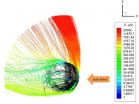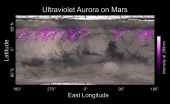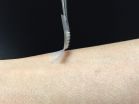(Press-News.org) If planets had personalities, Mars would be a rock star according to recent preliminary results from NASA's MAVEN spacecraft. Mars sports a "Mohawk" of escaping atmospheric particles at its poles, "wears" a layer of metal particles high in its atmosphere, and lights up with aurora after being smacked by solar storms. MAVEN is also mapping out the escaping atmospheric particles. The early results are being discussed at a MAVEN-sponsored "new media" workshop held in Berkeley, California, on June 19-21.
The Mars Atmosphere and Volatile Evolution (MAVEN) spacecraft was launched toward Mars on Nov. 18, 2013, to discover how the Red Planet lost much of its atmosphere, transforming its climate from one that could have supported life billions of years ago into its present cold and barren state.
In light of its continued scientific success, the MAVEN mission was extended from November of this year through September of 2016. This will bring the MAVEN mission cycle in synch with the wider planetary mission review process, planned in 2016, that will determine future mission extensions.
Atoms in the Martian upper atmosphere become electrically charged ions after being energized by solar and space radiation. Because they are electrically charged, these ions feel the magnetic and electric forces of the solar wind, a thin stream of electrically conducting gas blown from the surface of the Sun into space at about a million miles per hour. The solar wind and more violent solar activity, such as solar flares and Coronal Mass Ejections, have the ability to strip away ions from Mars' upper atmosphere through electric and magnetic forces generated by a variety of mechanisms, causing the atmosphere to become thinner over time. MAVEN's goal is to discover which mechanisms are most prominent for atmospheric loss, and to estimate the rate at which the Martian atmosphere is being eroded away.
"MAVEN is observing a polar plume of escaping atmospheric particles," said Bruce Jakosky of the University of Colorado, Principal Investigator for MAVEN. "The amount of material escaping by this route could make it a major player in the loss of gas to space." Preliminary MAVEN observations of this phenomenon were presented in March at the Lunar and Planetary Science Conference in Houston, Texas.
Theoretical models had predicted that the electric field generated by the incoming solar wind could drive ions in the direction of one pole or the other, creating a polar plume of escaping ions. "When tracing particle trajectories in the models, the plume looks a bit like a 'Mohawk'," said David Brain of the University of Colorado, an interdisciplinary scientist working on the MAVEN mission.
MAVEN has also detected a long-lived layer in the electrically charged upper atmosphere (the ionosphere) of Mars made up of metal ions (iron and magnesium) that come from incoming solar-system debris, such as comet dust and meteorites. The incoming material is heated up by the atmosphere as it enters, burns up and vaporizes, and even ionizes.
"MAVEN had previously detected the metal ion layer associated with dust from the close passage of Comet Siding Spring last October," said Jakosky. "When MAVEN did its first 'deep dip' campaign in February, and lowered the closest point of the spacecraft's orbit to around 125 kilometers (almost 78 miles) altitude, we immediately detected metal ions that still resided in the upper atmosphere. As there was no comet encounter at around that time, this must be the long-lived layer that we expect to be present."
The spacecraft has also seen the Red Planet lighting up under the impact of violent solar activity. Coronal Mass Ejections (CMEs) blast billions of tons of solar material into space at millions of miles per hour. Because Mars is not protected by a global magnetic field like Earth, CME particles directly impact the Martian upper atmosphere, generating diffuse displays of light called aurora. The high-energy particles from the Sun hit the upper atmosphere, excite the atoms that are there, and the atoms give off energy as they "relax" to their ground state. On Earth, the effect of our magnetic field concentrates auroral displays near the Polar Regions, where they are known as the Northern and Southern lights. On Mars, the aurora seen by MAVEN is more diffuse, and the effects also could drive the escape of atmospheric gas into space.
MAVEN has previously observed a diffuse aurora on Mars, during an intense solar electron storm that occurred just before Christmas last year, publicized in a press release in mid-March. The mission has now seen two additional occurrences of aurora associated with CME events in March, according to Jakosky.
MAVEN is also mapping the escaping atmospheric particles. "We can make maps separated according to low and high solar wind pressure, or other drivers of escape," said Brain. "What we learn about the variability in escape rates will allow us to estimate how the escape rate has changed over solar system history."
INFORMATION:
MAVEN's principal investigator is based at the University of Colorado's Laboratory for Atmospheric and Space Physics in Boulder. The university provided two science instruments and leads science operations, as well as education and public outreach, for the mission. The University of California at Berkeley's Space Sciences Laboratory provided four science instruments for the mission. NASA's Goddard Space Flight Center in Greenbelt, Maryland, manages the MAVEN project and provided two science instruments for the mission. Lockheed Martin built the spacecraft and is responsible for mission operations. NASA's Jet Propulsion Laboratory, Pasadena, California, provides navigation and Deep Space Network support, as well as the Electra telecommunications relay hardware and operations.
COLUMBIA, Mo. - In 1964, renowned biologists Peter Raven and Paul Erhlich published a landmark study that introduced the concept of co-evolution. Using butterflies and plants as primary examples, the team determined that two species can reciprocally drive each other's evolution and development. Now, an international team of researchers led by the University of Missouri and Stockholm University has used cutting-edge genomics to analyze the co-evolution theory and identified the mechanisms responsible for this phenomenon. Scientists believe that understanding how co-evolution ...
Our brains track moving objects by applying one of the algorithms your phone's GPS uses, according to researchers at the University of Rochester. This same algorithm also explains why we are fooled by several motion-related optical illusions, including the sudden "break" of baseball's well known "curveball illusion."
The new open-access study published in PNAS shows that our brains apply an algorithm, known as a Kalman filter, when tracking an object's position. This algorithm helps the brain process less than perfect visual signals, such as when objects move to the ...
Amid reports that rank today's teens as the most stressed generation in the country, a new study offers hope for helping them effectively manage stress and build long-term resiliency. A pilot study, published in the spring issue of the journal Advances in Mind-Body Medicine, describes how a stress-reduction/resiliency-building curriculum developed by the Benson-Henry Institute (BHI) at Massachusetts General Hospital (MGH) helped a group of Boston-area high school students significantly reduce their anxiety levels, increase productivity and effectively manage stress over ...
PROVIDENCE, R.I. [Brown University] -- Fish are power eaters. In many species, large muscles running along their backs and bellies provide bursts of speed for chasing down prey. Then, at the very instant they close in, they vacuum victims into their suddenly gaping mouths with overwhelming suction. It turns out that these power surges are no anatomical coincidence. A new study shows that largemouth bass get their slurping power from the very same muscles that provide their swimming power.
In the Proceedings of the National Academy of Sciences, Brown University researchers ...
Chemists and biologists at UC San Diego have succeeded in designing and synthesizing an artificial cell membrane capable of sustaining continual growth, just like a living cell.
Their achievement, detailed in a paper published in this week's issue of the Proceedings of the National Academy of Sciences, will allow scientists to more accurately replicate the behavior of living cell membranes, which until now have been modeled only by synthetic cell membranes without the ability to add new phospholipids.
'The membranes we created, though completely synthetic, mimic several ...
WASHINGTON (June 18, 2015) -- Research published in the Proceedings of the National Academy of Sciences found that some individuals exposed to HIV-1, but who remain uninfected, have a certain pattern of virus-specific immune responses that differentiated them from individuals who became infected. The findings build upon prior research by studying these responses in the context of a controlled clinical trial, examining a large number of subjects, and by having access to specimens saved before anyone was infected. In the future, this information could be used to assess HIV-1 ...
CHAPEL HILL, NC - Painful insulin injections could become a thing of the past for the millions of Americans who suffer from diabetes, thanks to a new invention from researchers at the University of North Carolina and NC State, who have created the first "smart insulin patch" that can detect increases in blood sugar levels and secrete doses of insulin into the bloodstream whenever needed.
The patch - a thin square no bigger than a penny - is covered with more than one hundred tiny needles, each about the size of an eyelash. These "microneedles" are packed with microscopic ...
New Vanderbilt-led research shows hospitals are doing a better job of using antibiotics less commonly associated with antibiotic resistance to treat children hospitalized with community-acquired pneumonia (CAP).
The report, 'Antibiotic choice for children hospitalized with pneumonia and adherence to national guidelines,' was released today in the journal Pediatrics.
This study was nested within a larger study, the Centers for Disease Control and Prevention (CDC) Etiology of Pneumonia in the Community (EPIC). The multi-center EPIC study was a prospective, population-based ...
DURHAM, N.C. -- Time management isn't just important for busy people -- it's critical for plants, too. A Duke University study shows how two biological clocks work together to help plants deal with intermittent demands such as fungal infections, while maintaining an already-packed daily schedule of activities like growth.
The researchers also identified a gene that senses disturbances in the 'tick-tock' of one clock, and causes the other clock to tighten its timetable. Their work appears in the June 22 issue of the journal Nature.
From daily sleep/wake cycles and fluctuations ...
For diabetics, a quick prick of the finger can give information about their blood glucose levels, guiding them in whether to have a snack or inject a dose of insulin. Point-of-care glucose meters, or glucometers, are also used in the veterinary world to monitor cats and dogs with diabetes or pets hospitalized for other reasons. In both cases, the device's readout can literally be a matter of life and death.
While glucometers have the advantage of being fast and requiring only a small drop of blood, they are not as accurate as some other methods of measuring blood glucose. ...





